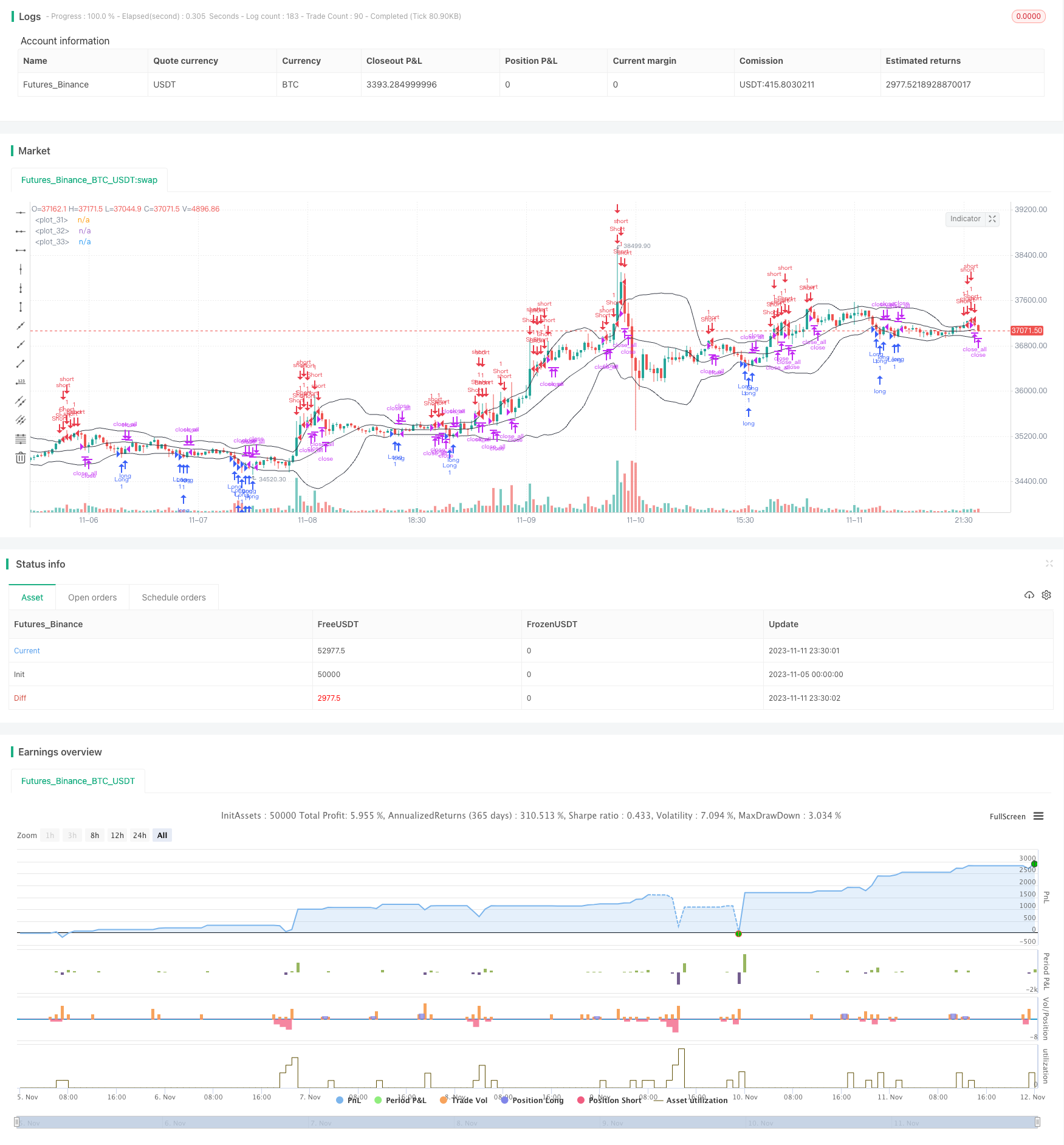
概述
该策略是基于布林带指标的突破策略,利用布林带上下轨Provide突破信号,进行买入和卖出操作。该策略同时具有追踪止损和加仓机制,可以在趋势行情中获得更高收益。
策略原理
该策略首先计算布林带的中轨、上轨和下轨。中轨是价格的移动平均线,上轨和下轨分别是中轨上下各自一个标准差。
当价格上穿下轨时,产生买入信号;当价格下穿上轨时,产生卖出信号。这表示价格突破布林带范围,可能进入趋势行情。
此外,该策略还判断实体突破,如果收盘价高于开盘价,且实体突破中轨一定比例,则平仓;如果收盘价低于开盘价,且实体突破中轨一定比例,则平仓。这可以避免假突破带来的损失。
在开仓后,该策略可以进行止损和加仓操作。如果价格继续朝有利方向运行,则可以加大仓位,增加盈利可能。如果价格反转,通过止损来控制风险。
优势分析
该策略具有以下优势:
利用布林带指标判断趋势方向和突破,这种技术指标简单有效。
结合实体和中轨判断突破可靠性,可避免假突破带来损失。
采用追踪止损来控制风险,可锁定盈利。
采用加仓方式,可以在趋势行情中获得更高收益。
策略逻辑清晰易理解,参数设置简单,易于实施。
风险分析
该策略也存在以下风险:
布林带突破无法完全避免假突破,仍存在一定损失风险。
止损点设置不当可能造成过早止损或止损无效。
加仓次数和加仓比例设定不当可能导致亏损扩大。
趋势反转时无法及时止损退出,可能带来较大亏损。
参数优化不够充分,可能导致策略效果不佳。
存在过拟合风险,需要在不同市场中进行验证。
优化方向
该策略可以从以下几个方面进行优化:
对布林带参数进行测试和优化,找到更合适的参数组合。
测试不同的止损策略,设定更精确的止损点。
对加仓次数和加仓比例进行测试,找到最优参数。
增加趋势判断指标,避免逆势加仓。
优化实体突破的判断逻辑,降低假突破概率。
增加条件单功能,根据不同市场情况使用不同的参数组合。
在更多不同的品种和时间周期中进行回测,提高稳定性。
采用机器学习等方法自动优化参数。
总结
总体来说,该策略利用布林带指标判断趋势方向和突破信号,并配以止损、加仓等功能,可以获得较好的效果。但也存在一定的风险,需要通过参数优化、增加条件判断等方式进行改进,使策略更稳定可靠。此策略适合熟悉技术分析的投资者使用,可以在趋势行情中获得较好收益。
/*backtest
start: 2023-11-05 00:00:00
end: 2023-11-12 00:00:00
period: 30m
basePeriod: 15m
exchanges: [{"eid":"Futures_Binance","currency":"BTC_USDT"}]
*/
//Noro
//2018
//@version=2
strategy("Noro's Bollinger Strategy v1.1", shorttitle = "Bollinger str 1.1", overlay = true, default_qty_type = strategy.percent_of_equity, default_qty_value = 100.0, pyramiding = 5)
//Settings
needlong = input(true, defval = true, title = "Long")
needshort = input(true, defval = true, title = "Short")
length = input(20, defval = 20, minval = 1, maxval = 1000, title = "Bollinger Length")
mult = input(2.0, minval = 0.001, maxval = 50, title = "Bollinger Mult")
source = input(ohlc4, defval = ohlc4, title = "Bollinger Source")
showbands = input(true, defval = true, title = "Show Bollinger Bands")
fromyear = input(2018, defval = 2018, minval = 1900, maxval = 2100, title = "From Year")
toyear = input(2100, defval = 2100, minval = 1900, maxval = 2100, title = "To Year")
frommonth = input(01, defval = 01, minval = 01, maxval = 12, title = "From Month")
tomonth = input(12, defval = 12, minval = 01, maxval = 12, title = "To Month")
fromday = input(01, defval = 01, minval = 01, maxval = 31, title = "From day")
today = input(31, defval = 31, minval = 01, maxval = 31, title = "To day")
//Bollinger Bands
basis = sma(source, length)
dev = mult * stdev(source, length)
upper = basis + dev
lower = basis - dev
//Lines
col = showbands ? black : na
plot(upper, linewidth = 1, color = col)
plot(basis, linewidth = 1, color = col)
plot(lower, linewidth = 1, color = col)
//Body
body = abs(close - open)
abody = ema(body, 30)
//Signals
up = close <= lower
dn = close >= upper
exit = (strategy.position_size > 0 and close > open) or (strategy.position_size < 0 and close < open) and body > abody / 2
//Trading
if up
strategy.entry("Long", strategy.long, needlong == false ? 0 : na, when=(time > timestamp(fromyear, frommonth, fromday, 00, 00) and time < timestamp(toyear, tomonth, today, 00, 00)))
if dn
strategy.entry("Short", strategy.short, needshort == false ? 0 : na, when=(time > timestamp(fromyear, frommonth, fromday, 00, 00) and time < timestamp(toyear, tomonth, today, 00, 00)))
if time > timestamp(toyear, tomonth, today, 00, 00) or exit
strategy.close_all()